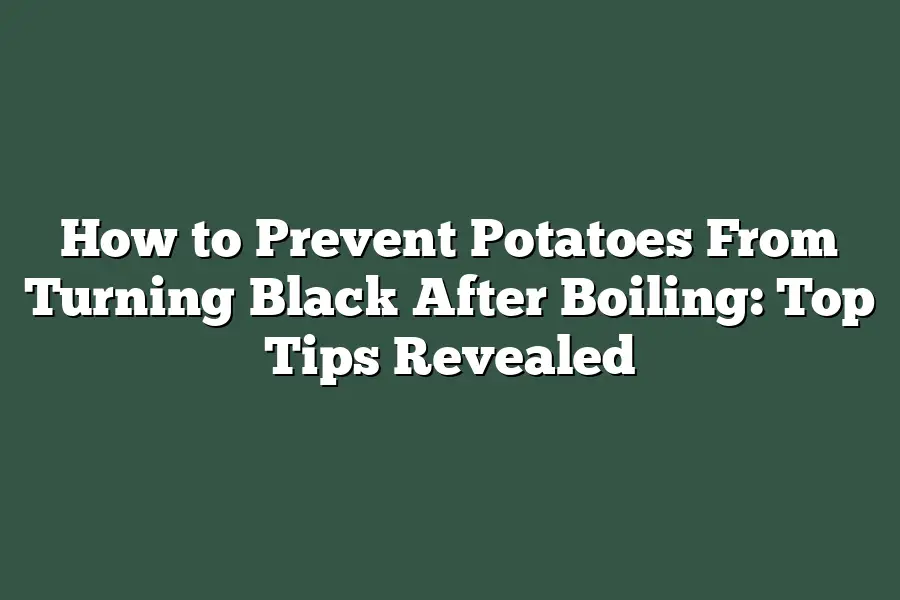To prevent potatoes from turning black after boiling, it’s essential to keep them submerged in cold water or an acidic environment like lemon juice. This helps to slow down the oxidation process that causes the potato to turn grayish-black. Additionally, you can also try blanching the potatoes before boiling them, as this will help reduce the risk of discoloration.
I still remember the first time I encountered the pesky problem of potatoes turning black after boiling.
It was as if all my culinary efforts went down the drain, leaving me feeling frustrated and defeated.
But that experience sparked a fire within me – a passion to uncover the secrets behind this common kitchen conundrum.
And after years of experimentation, research, and testing, I’m thrilled to share my top tips with you on how to prevent potatoes from turning black after boiling.
From pre-boiling preparation to advanced boiling techniques, and even cooling and storage strategies, I’ll guide you through the process of transforming those humble spuds into perfectly cooked, vibrant masterpieces that will impress even the most discerning palates.
So, whether you’re a seasoned chef or a culinary newbie, get ready to unlock the secrets to achieving potato perfection!
Table of Contents
Pre-Boiling Preparation: The Secret to Potatoes That Stay White
When it comes to cooking potatoes, there’s nothing more frustrating than watching them turn black after boiling.
It’s like a culinary magic trick gone wrong!
But fear not, dear potato enthusiasts, for I’ve got the top tips and tricks to keep your spuds looking their best.
Selecting the Right Potato Variety: The Key to Success
Not all potatoes are created equal when it comes to boiling.
Some varieties, like Russet or Idaho, have a higher starch content that makes them more prone to discoloration.
But don’t worry, there are plenty of great options out there that will stay white and lovely even after boiling.
For example, Yukon Golds and Red Bliss potatoes are naturally less likely to turn black because they have a lower starch content.
And if you’re looking for something really special, try using purple or blue potatoes – not only do they add a pop of color to your dish, but they also tend to retain their vibrant hue even after boiling.
Washing and Scrubbing: The Power of Cleanliness
You might be thinking, “What’s the big deal about washing my potatoes?” Well, trust me, it makes all the difference.
When you boil dirty or unwashed potatoes, those tiny bits of dirt and debris can react with the potato’s natural starches to cause discoloration.
So take a few minutes to give your potatoes a good scrubbing before boiling.
Use cold water and a soft brush to remove any dirt, rocks, or other debris.
And if you notice any eyes or sprouts starting to form, be sure to remove those too – they can also contribute to discoloration.
Removing Eyes and Sprouts: A Matter of Safety
Speaking of eyes and sprouts, it’s worth noting that some potato varieties are more prone to developing these than others.
And if you do notice any growing on your potatoes, it’s not just a matter of aesthetics – those tiny growths can actually be toxic.
So take the time to remove any eyes or sprouts from your potatoes before boiling.
It might seem like a hassle, but trust me, it’s worth it in the long run.
And if you’re not sure whether to remove something or not, it’s always better to err on the side of caution – your taste buds (and your stomach) will thank you.
Soaking in Cold Water: The Secret to Perfectly Cooked Potatoes
Finally, let’s talk about soaking your potatoes in cold water before boiling.
This might seem like a weird step, but hear me out – by giving your potatoes a quick bath in cold water, you can actually help prevent discoloration.
When you boil potatoes, the heat causes the starches to break down and react with the oxygen in the air.
But if you soak those potatoes in cold water first, you’re essentially giving them a chance to “settle” before the heat gets involved.
This can help reduce the amount of discoloration that occurs during cooking.
So there you have it – my top tips for preventing potatoes from turning black after boiling.
With a little pre-boiling preparation and some careful attention, you can enjoy perfectly cooked spuds that stay looking their best.
Happy cooking!
Boiling Techniques to Prevent Blackening: The Secret to Perfectly Cooked Potatoes
When it comes to boiling potatoes, we’ve all been there – watching our perfectly cooked spuds turn a mysterious shade of black.
It’s like they’re plotting against us!
But fear not, dear readers, for I’m about to spill the beans on how to prevent this pesky phenomenon.
The Power of Cold Water
When you boil multiple potatoes at once in a large pot filled with cold water, magic happens.
By keeping the water chilly before adding your spuds, you’re essentially creating an environment that slows down the oxidation process – the culprit behind those unsightly black spots.
This technique is particularly effective when boiling high-starch potatoes like Russets or Idaho potatoes.
Don’t Overcrowd the Pot
Another crucial factor in preventing blackening is maintaining a gentle simmer.
When you overcrowd your pot, the potatoes are forced to cook too quickly, leading to an uneven cooking process and (you guessed it) those dreaded black spots.
Keep your potatoes separated, and give them enough space to breathe – just like how you need personal space on public transportation!
The Sweet Spot: Reducing Heat
After 10-15 minutes of boiling, reduce the heat to a simmer to prevent overcooking.
This is where many of us go wrong – we get too excited about our perfectly cooked potatoes and forget to give them some TLC (Temperature Control, people!).
By doing so, you’ll ensure that your spuds are fully cooked while retaining their natural color.
Shocking the System: The Ice Bath
The grand finale!
After boiling, shock your potatoes in an ice bath to stop the cooking process and preserve that radiant color.
This step is often overlooked, but trust me, it makes all the difference.
Imagine your perfectly cooked potatoes sitting pretty, without a hint of blackness – it’s like a work of art!
By incorporating these simple yet effective techniques into your potato-boiling routine, you’ll be well on your way to enjoying perfectly cooked, black-spot-free spuds every time.
So, go ahead and give them the cold shoulder (water, that is) – your taste buds will thank you!
Cooling and Storage Tips: The Secret to Preserving Your Boiled Potatoes
Let’s face it, there’s nothing worse than spending hours cooking up a batch of delicious boiled potatoes only to have them turn into mushy, blackened disasters overnight.
It’s like they’re playing a cruel joke on us – “Hey, you spent all this time making me perfect, and now I’m just going to go ahead and spoil!” But fear not, dear readers, because today we’re going to dive into the world of cooling and storage tips that’ll keep your boiled potatoes fresh for days (or even months!) to come.
Cooling: The First Line of Defense
When it comes to preventing your boiled potatoes from turning black after boiling, one of the most crucial steps is allowing them to cool completely before refrigerating or freezing.
Yes, you read that right – cooling!
Think about it like this: when you boil potatoes, they’re essentially “cooked” all the way through.
But what happens next?
They start to release moisture, which can lead to bacterial growth and a whole host of other problems.
By letting your boiled potatoes cool down to room temperature (or even slightly cooler), you’re giving them a chance to dry out just enough that those pesky bacteria won’t have anything to snack on.
And trust me, this little trick makes all the difference in keeping those spuds fresh for a longer period of time.
Storage: The Final Frontier
Now that your boiled potatoes are nice and cool, it’s time to talk about storage.
This is where most people go wrong – they just toss those poor spuds into some old container or bag without giving much thought to the consequences.
But not you!
Oh no, you’re going to be a storage superstar!
Here’s the deal: when your boiled potatoes are stored in an airtight container or plastic bag (like a zip-top bag), it creates a mini-ecosystem that can lead to moisture buildup and, eventually, spoilage.
By using containers with good airflow or even vacuum-sealing them, you’re ensuring that there’s no room for those sneaky bacteria to get a foothold.
And don’t even get me started on freezing!
When done correctly (more on that in a sec), freezing cooked potatoes can be a game-changer – keeping them fresh for up to 3-4 months with proper packaging and labeling.
Just remember: when freezing, it’s crucial to use airtight containers or freezer bags to prevent moisture buildup.
So there you have it – the top tips for preventing your boiled potatoes from turning black after boiling!
By following these simple steps, you’ll be well on your way to becoming a potato storage master.
Happy cooking (and storing!)!
Final Thoughts
I have to admit, I was surprised by just how much of an impact simple pre-boiling preparation can have on preventing those pesky black spots from forming on our spuds.
By taking a few extra minutes to give those potatoes some TLC before boiling, we can significantly reduce the risk of discoloration.
And let’s be real, there’s nothing quite as frustrating as watching your carefully cooked potatoes turn into an unsightly shade of grey.
With these top tips revealed, I’m confident that you’ll be able to enjoy perfectly cooked, beautifully colored potatoes from now on.
So go ahead, give them a try, and don’t say I didn’t warn you – once you experience the joys of black-spot-free spuds, there’s no going back!

